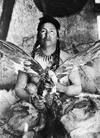- Assiniboin
-
1. a member of a Siouan people of northeastern Montana and adjacent parts of Canada.2. the dialect of Dakota spoken by the Assiniboin Indians.[1675-85; < CanF Assiniboine < Ojibwa (Saulteaux dial.) assini·-pwa·n lit., stone Sioux (equiv. to Proto-Algonquian *asenyi stone + *pwa·tha enemy tribesman)]
* * *
or NakotaNorth American Plains Indian people living mostly on reservations in Montana, U.S., and Saskatchewan and Alberta, Can.They speak a Siouan language. Their name is an Ojibwa word meaning "those who cook with stones." They were divided into bands, each with its own chief and council, and were generally friendly with whites. The bands moved their camps frequently in pursuit of migrating buffalo. Prowess in war consisted of taking scalps and horses and of touching the enemy ("counting coups") during battle. Their numbers were severely reduced by smallpox in the 1820s and '30s, after which most were placed on reservations. Some 3,900 people claimed sole Assiniboin descent in the 2000 U.S. census. There are somewhat fewer in Canada. Assiniboin, placating the spirit of a slain eagle, photograph by Edward S. Curtis, 1908; from ...Courtesy of the Newberry Library, Chicago, Ayer Collection
Assiniboin, placating the spirit of a slain eagle, photograph by Edward S. Curtis, 1908; from ...Courtesy of the Newberry Library, Chicago, Ayer Collection* * *
▪ peoplealso called StoniesNorth American Plains Indians belonging to the Siouan (Siouan languages) linguistic family. During their greatest prominence the tribe lived in the area west of Lake Winnipeg along the Assiniboin and Saskatchewan rivers, in what are now the Canadian provinces of Alberta, Saskatchewan, and Manitoba.The name of the tribe is derived from the Ojibwa (Chippewa) term meaning “one who roasts using stones,” and the Assiniboin are thus known as “Stonies” in Canada. Although the Assiniboin spoke a Siouan dialect, Nakota, sometime before the 17th century they had broken with the powerful group of Sioux who spoke the Dakota dialect. Subsequently, the Assiniboin and Dakota engaged in an almost constant cycle of raiding and defense; as a result, the Assiniboin formed an alliance with the Cree, who joined the tribe in activities against the Dakota.Traditionally, the Assiniboin were great buffalo hunters known for exchanging pemmican (preserved buffalo meat) for firearms and other European goods brought in by traders on the Hudson Bay and the upper Missouri. The continuous encroachment of British and French fur traders and settlers caused the tribe to move gradually westward into the plains of what are now Canada and the U.S. states of Montana and North Dakota, bringing them into confrontation with the Blackfoot over control of the northern Plains.Assiniboin social life was organized through independent bands, each with its own chief and council. The bands moved their camps frequently in pursuit of buffalo; before the introduction of horses in the 18th century, bands moved on foot and used dog-drawn travois. Women were responsible for all work related to the lodges (tepees), food preparation, and the production of clothing and other necessities from the buffalo. Men's work involved hunting and battle; prowess in war consisted of the taking of scalps and horses and of “counting coup,” or touching the enemy, during battle. War party leaders received their instructions in visions or dreams. In spite of their warrior tradition, or perhaps because of confidence in their defensive capabilities, the Assiniboin were exceptionally friendly with traders. As with many other Plains Indians (Plains Indian), their most significant religious ceremony was the Sun Dance. Assiniboin power and prominence were severely reduced by recurrent smallpox epidemics that swept the region in the 1820s and '30s, after which most of the Assiniboin were relocated to reservations.Early 21st-century population estimates indicated some 7,000 individuals of Assiniboin descent.* * *
Universalium. 2010.
